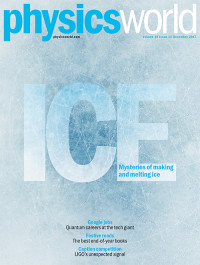Tag archives: ice
Physics of ski jackets, the eerie sound of thin ice, how figure skaters linger in mid-air
By Michael Banks and Hamish Johnston
Probably with an eye on the Winter Olympics, which starts today, two firms have just released new ranges of high-tech ski jackets. The Swiss technology business Osmotex and the Swiss Federal Laboratories for Materials Science and Technology premiered their new ski jacket at the sport and sportwear international (ISPO) trade fair in Munich. It contains an “electro-osmotic” membrane called HYDRO_BOT in the fabric so that when membrane is switched on with a conventional battery it speeds up the transfer of salt ions across the membrane, taking them away from your sweaty skin. The creators claim it can pump out 10 litres of liquid per square metre per hour. For more details, see the video above.
View all posts by this author | View this author's profile
It’s a cracker – the December 2017 issue of Physics World is now out
 By Matin Durrani
By Matin Durrani
The December 2017 issue of Physics World, which is now out in print and digital format, has some great treats for you.
We’ve got two ice-related features – one by Jennifer Ouellette on a new “inverse” Mpemba effect, which suggests that cold water could warm faster than hot, and the other by two Norwegian researchers studying how best to treat wintry roads with salt.
Then there’s our festive reviews special, where we cast our eye over some of the best end-of-year reads, ranging from the physics of everyday life to extrasolar planets. Plus we review the “tremendous” new documentary about the Voyager missions.
Finally don’t miss our insight into quantum-computing careers at Google plus our great end-of-year LIGO-related caption competition.
Remember that if you’re a member of the Institute of Physics, you can read the whole of Physics World magazine every month via our digital apps for iOS, Android and Web browsers.
View all posts by this author | View this author's profile
Icy spray from Saturn’s moon Enceladus sampled by Cassini

Cassini’s enhanced and false-coloured image of Enceladus backlit by the Sun shows the fountain-like plumes of the fine spray of material that spews from the south polar region (Courtesy: NASA/JPL/Space Science Institute)
By Tushna Commissariat
Enceladus, Saturn’s sixth largest moon is back in the news as the Cassini-Huygens mission has managed to directly sample the water plumes jetting into space from its southern polar region. These plumes of ice and salt originate from the moon’s famed “tiger stripes” region – four parallel giant fissures on the southern face of the moon.
The findings from these fly-throughs are the strongest evidence yet for the existence of large-scale saltwater reservoirs beneath the moon’s icy crust. “Enceladus is a tiny icy moon located in a region of the outer solar system where no liquid water was expected to exist, because of its large distance from the Sun,” says Nicolas Altobelli, ESA’s project scientist for the Cassini-Huygens mission. “This finding is therefore a crucial new piece of evidence showing that environmental conditions favourable to the emergence of life may be sustainable on icy bodies orbiting gas-giant planets.”
Indeed, the moon has been described previously by other Cassini researchers as one of the “most habitable spots beyond Earth in the solar system for life as we know it”.
Enceladus’ water plumes are though to contribute towards replenishing Saturn’s outermost and faint E-ring, which traces the orbit of Enceladus around Saturn. The Cassini spacecraft discovered the plumes in 2005 and more recently has been able to fly directly through them.
During three of Cassini’s passes in 2008 and 2009, its Cosmic Dust Analyser measured the composition of freshly ejected plume grains. The icy particles hit the detector target at speeds of 6.5–17.5 km/s, and vaporized instantly. Electrical fields inside the instrument then separated the various constituents of the resulting impact cloud for analysis.
Researchers looking at the data from the detector have found that grains ejected in the plumes and into the atmosphere of the moon and out towards the E-ring are relatively small and mostly salt-poor, closely matching the composition of the E-ring. However, closer to the moon itself relatively large, salt-rich ice grains were found.

This mosaic of 21 Cassini images is a false colour full-disc view of the anti-Saturn hemisphere on Enceladus (Courtesy: NASA/JPL/Space Science Institute)
Scientists explain this by saying that more than 99% of the total mass of ejected solids is in salt-rich grains, but most of these are heavy and fall back to the moon, so never make it into the E-ring. The salt-rich particles have an “ocean-like” composition which indicates that most, if not all, of the expelled ice comes from liquid saltwater body somewhere under the surface, rather than from the icy face of the moon.
The scenario envisioned by the team goes something like this – deep underneath Enceladus’ surface, perhaps 80 km down, there is a reservoir of water between the rocky core and the icy mantle, kept liquid by tidal forces generated by Saturn and its neighbouring moons, as well as by the heat generated by radioactive decay. When the outermost layer cracks open, the reservoir is exposed to space. The drop in pressure causes the liquid to evaporate, with some of it flash-freezing into salty ice grains: together these create the plumes.
When salty water freezes slowly, the salt is squeezed out, leaving pure water ice behind. So, if the plumes were coming from the surface ice, there should be very little salt in them. “There currently is no plausible way to produce a steady outflow of salt-rich grains from solid ice across the tiger stripes other than from saltwater under Enceladus’ icy surface,” says Frank Postberg, Universität Heidelberg, Germany, who is the lead author of a Nature paper announcing these results.